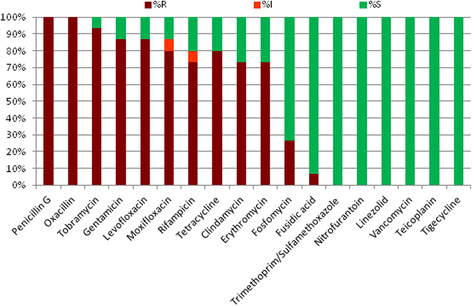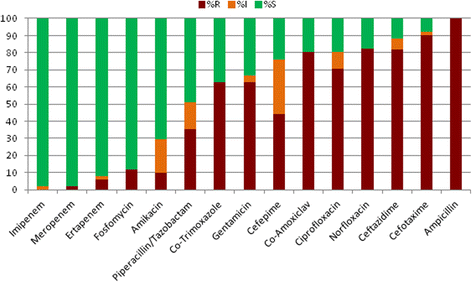Carriage of multidrug-resistant organisms in a tertiary university hospital in Albania-a point prevalence survey
- PMID: 27499852
- PMCID: PMC4975909
- DOI: 10.1186/s13756-016-0128-1
Carriage of multidrug-resistant organisms in a tertiary university hospital in Albania-a point prevalence survey
Abstract
Background: Antimicrobial resistance has been recognised as a serious global Public Health problem. Prevalence of Multiple-Drug-Resistant (MDR) organism carriage in Albania is largely unknown since no national surveillance system is in place and few publications are accessible in the literature.
Methods: A 1-day point-prevalence-survey (PPS) screening for nasal methicillin-resistant Staphylococcus aureus (MRSA) and rectal MDR Gram-negative carriage was carried out at the high-dependency wards in the country's only tertiary care hospital, in Tirana.
Results: A total of 106 nasal and 104 rectal swabs were collected. 14.2 % of patients (95 % Confidence Interval [95 CI]: 8.1-22.3 %) were MRSA nasal carriers. Resistance to aminoglycosides and fluoroquinolones was common in these isolates (≥80 %) but no resistance was identified against glycopeptides, nitrofurantoin and the relatively newer agents, tigecycline and linezolid. Fifty Enterobacteriaceae isolates were cultivated from 33 of 104 screened patients (31.7 % [95 CI: 22.9-41.6 % 95 CI]). The prevalence of Extended Spectrum Beta-Lactamase (ESBL) production in Enterobacteriaceae was 41.3 % (95 CI: 31.8-51.4 %). The two more commonly isolated Enterobacteriaceae were E. coli ([n = 28], 24 ESBL positive; 1 AmpC positive and 3 without an identified mechanism of resistance) and Klebsiella pneumoniae ([n = 13], all ESBL positive; 1 also AmpC and metallo-β-lactamase (MBL) positive). Susceptibility to carbapenems (≥98 %), fosfomycin (90 %) and amikacin (70 + 20 % intermediate) was high but a high level of resistance to all other agents tested was noted. Non-fermenting Gram-negative bacilli were less commonly isolated {22 isolates: Acinetobacter baumannii (9); Pseudomonas aeruginosa (8) and Stenotrophomonas maltophilia (5)}.
Conclusion: Although a significant rate of MRSA carriage was identified, the main resistance challenge in Albania appears to be linked with Gram-negative organisms, particularly ESBL in Enterobacteriaceae.
Keywords: Antimicrobial-resistance; ESBL; Enterobacteriaceae; Infection-prevention; Meticillin resistant staphylococcus aureus (MRSA).
Figures
References
-
- World Health Organization. Antimicrobial resistance in the European Union and the world. WHO, 2013. http://www.who.int/dg/speeches/2012/amr_20120314/en/.
-
- World Health Organization. Antimicrobial resistance: global report on surveillance. WHO, 2014. http://apps.who.int/iris/bitstream/10665/112642/1/9789241564748_eng.pdf?....
-
- Maechler F, Peña Diaz LA, Schröder C, Geffers C, Behnke M, Gastmeier P. Prevalence of carbapenem-resistant organisms and other Gram-negative MDRO in German ICUs: first results from the national nosocomial infection surveillance system (KISS) Infection. 2015;43:163–168. doi: 10.1007/s15010-014-0701-6. - DOI - PubMed
LinkOut - more resources
Full Text Sources
Other Literature Sources
Miscellaneous




